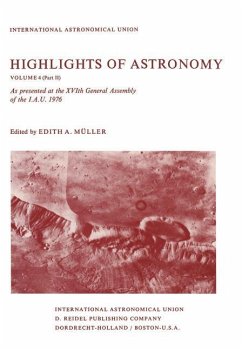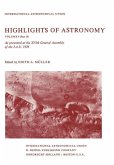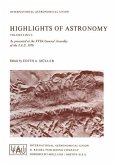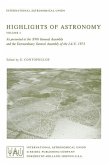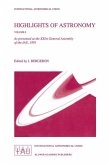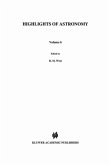MüllerPart II As Presented at the XVIth General Assembly 1976
Highlights of Astronomy
Part II As Presented at the XVIth General Assembly 1976
Herausgegeben:Müller, E. A.
MüllerPart II As Presented at the XVIth General Assembly 1976
Highlights of Astronomy
Part II As Presented at the XVIth General Assembly 1976
Herausgegeben:Müller, E. A.
- Broschiertes Buch
- Merkliste
- Auf die Merkliste
- Bewerten Bewerten
- Teilen
- Produkt teilen
- Produkterinnerung
- Produkterinnerung
It has become a tradition in the Union to publish the Invited Discourses and the Proceedings of the Joint Discussions held at a Gene ral Assembly in a separate volume entitled HIGHLIGHTS OF ASTRONOMY. This is the fourth volume of its kind and it contains some of the scientific highlights of the Grenoble General Assembly. In order to reduce its size it was decided to publish its content in two separate parts. The part (I) contains the full texts of the In vited Discourses given by Prof. J.-C. Pecker and by Dr. C. Sagan, and an abstract of Dr. P. Morrison's paper, thus complying with his wish to…mehr
Andere Kunden interessierten sich auch für
![Highlights of Astronomy Highlights of Astronomy]() E.A. Mller (ed.)Highlights of Astronomy116,99 €
E.A. Mller (ed.)Highlights of Astronomy116,99 €![Highlights of Astronomy Highlights of Astronomy]() E.A. Mller (ed.)Highlights of Astronomy39,99 €
E.A. Mller (ed.)Highlights of Astronomy39,99 €![Highlights of Astronomy Highlights of Astronomy]() WestHighlights of Astronomy231,99 €
WestHighlights of Astronomy231,99 €![Highlights of Astronomy Highlights of Astronomy]() Highlights of Astronomy39,99 €
Highlights of Astronomy39,99 €![Highlights of Astronomy Highlights of Astronomy]() Jacqueline Bergeron (Hrsg.)Highlights of Astronomy116,99 €
Jacqueline Bergeron (Hrsg.)Highlights of Astronomy116,99 €![Highlights of Astronomy Highlights of Astronomy]() Richard M. West (ed.)Highlights of Astronomy229,99 €
Richard M. West (ed.)Highlights of Astronomy229,99 €![Highlights of Astronomy Highlights of Astronomy]() Highlights of Astronomy39,99 €
Highlights of Astronomy39,99 €-
-
-
It has become a tradition in the Union to publish the Invited Discourses and the Proceedings of the Joint Discussions held at a Gene ral Assembly in a separate volume entitled HIGHLIGHTS OF ASTRONOMY. This is the fourth volume of its kind and it contains some of the scientific highlights of the Grenoble General Assembly. In order to reduce its size it was decided to publish its content in two separate parts. The part (I) contains the full texts of the In vited Discourses given by Prof. J.-C. Pecker and by Dr. C. Sagan, and an abstract of Dr. P. Morrison's paper, thus complying with his wish to forego publication of the full text of his Discourse. Furthermore it collects the proceedings of three Joint Discussions and one Joint Meeting all of which are related essentially to observations from space, to external galaxies and to cosmology. Part (TI) contains the proceedings of the four Joint Discussions and one Joint Meeting related essentially to stars and the structure of our Galaxy. Clearly Volume 4 (parts I and TI) of the Highlights reflects only a part of the scientific activities which took place at the Grenoble General Assembly. Many more important papers and discussions were held during Commission meetings and joint meetings. They may be found in the Commissions' reports published in the Transactions Vol. XVI B, 1977.
Produktdetails
- Produktdetails
- International Astronomical Union Highlights 4/2
- Verlag: Springer / Springer Netherlands
- Artikelnr. des Verlages: 978-90-277-0832-8
- 1977.
- Seitenzahl: 416
- Erscheinungstermin: 30. September 1977
- Englisch
- Abmessung: 254mm x 178mm x 23mm
- Gewicht: 770g
- ISBN-13: 9789027708328
- ISBN-10: 9027708320
- Artikelnr.: 26574210
- Herstellerkennzeichnung
- Springer-Verlag GmbH
- Tiergartenstr. 17
- 69121 Heidelberg
- ProductSafety@springernature.com
- International Astronomical Union Highlights 4/2
- Verlag: Springer / Springer Netherlands
- Artikelnr. des Verlages: 978-90-277-0832-8
- 1977.
- Seitenzahl: 416
- Erscheinungstermin: 30. September 1977
- Englisch
- Abmessung: 254mm x 178mm x 23mm
- Gewicht: 770g
- ISBN-13: 9789027708328
- ISBN-10: 9027708320
- Artikelnr.: 26574210
- Herstellerkennzeichnung
- Springer-Verlag GmbH
- Tiergartenstr. 17
- 69121 Heidelberg
- ProductSafety@springernature.com
1. Galactic Structure in the Direction of the Polar Caps.- Introductory Remarks.- One Galactic Structure at Lower z Distances - Space Densities and Motions - The Solar Neighbourhood - M Dwarfs - Missing Mass.- M Dwarfs at Lower z Distances.- Available Stellar Data in Galactic Polar Areas.- Bibliography on Galactic Structure in the Direction of Polar Caps.- M Dwarfs and the Missing Mass.- Some Research Programmes into Galactic Structure at the Galactic Caps Under Way at the Royal Greenwich Observatory.- The Space Density of M Dwarfs - An Observational Program.- The Luminosity Function of Late-Type Main-Sequence Stars in the Direction of the North Galactic Cap.- Galactic Mass Density in the Vicinity of the Sun.- The Frequency of Faint M Giant Stars at High Galactic Latitudes.- General Discussion of Topics in Part One.- Two Galactic Structure at Higher z Distances - Space Densities and Motions - Different Stellar Populations and Chemical Abundances.- The Stellar Distribution Above the Galactic Plane: An Introduction.- Some Results of Classification of Stars in Kapteyn Areas Applied to Galactic Structure in NGP.- Mean Chemical Abundance of the F Stars as a Function of Distance from the Galactic Plane.- RGU Three-Colour-Photometry Towards the NGP: Halo-to-Disk Mass Ratio.- Density Law, Vertical Distribution and Vertical Gradient of Metal Abundances for G and K Giants.- Polarization Measurements and Extinction Near the NGP.- Parallaxes of Selected Stars Near the NGP.- Progress Report on a Search for Parallax Stars in the Region of the South Galactic Cap.- Search for Large Radial Velocities in the Direction of NGP Using the Fehrenbach Techniques.- The Gravitational Field of the Galaxy in the z Direction.- Berkeley Studies of Faint Stars at High Latitudes.-Swedish Programmes Concerning the z Distribution of Stars.- Studies of A and F Stars in the Region of the NGP.- The Distribution of Field Horizontal-Branch Stars in the Galactic Halo.- A New Program to Determine K (z) from Main Sequence Stars.- Objective-Prism Radial Velocities at High Latitudes.- Discussion of the Calculation of the Density Law (Dz).- Motions of Near-Polar K-Giants Along the z Coordinate.- General Discussion of Topics in Part Two.- Three Summary and Conclusions - Present Results and Future Problems for Study.- The Role of Proper Motions in Determining the Luminosity and Density Functions.- Concluding Remarks Part Two.- Current Results and Suggestions for Future Work.- 5. Stellar Atmospheres as Indicator and Factor of Stellar Evolution.- Introduction-Observational Evidence.- Introductory Talk.- Observational Evidence for Atmospheric Physical Characteristics Relevant to Stellar Evolution.- Behaviour of Microturbulence with Evolution.- Observational Evidence for Atmospheric Chemical Composition Peculiarities Relevant to Stellar Evolution.- Stellar Atmospheres as Boundary Condition of Internal Structure.- Sensitivity of Internal Structure to the Surface Boundary Condition.- Boundary Conditions with Mass Loss: General Considerations.- Mass Loss in Stars of Moderate Mass by Stellar Winds and Effects on the Evolution.- Boundary Condition with Mass Loss: The Radiatively-Driven Wind Model.- Alteration of Surface Chemical Composition of Stars by Transport Phenomena.- Stratification of Elements in a Quiet Atmosphere: Diffusion Processes.- Competition Between Diffusion Processes and Hydrodynamical Instabilities in Stellar Envelopes.- Alteration of Surface Chemical Composition of Stars by Nuclear Reaction.- Mixing Between Burned Core Material and SurfaceLayers.- Decay of Light Elements in Stellar Envelopes.- Conclusion.- 6. The Small Scale Structure of Solar Magnetic Fields.- Observations of Small-Scale Photospheric Magnetic Fields.- Small Scale Solar Magnetic Fields: Theory.- Some Comments on the Measurement of Small Scale Strong Magnetic Fields on the Sun.- Line Profiles of Faculae and Pores.- Facular Models, the K-Line, and Magnetic Fields.- Small Magnetostatic Flux Tubes.- Flows in Magnetic Flux Tubes.- Discussion.- Concluding Remarks.- 7. The Impact of Ultraviolet Observations on Spectral Classification.- Present Status of Spectral Classification in the Conventional Wavelength Range with Emphasis Upon Early-Type Stars.- Spectral Classification of Early-Type Stars from the Low Dispersion Ultraviolet Spectra.- Spectral Classification of B and A Stars from the Line Features of S2/68 Spectra.- Behaviors of B Star Continua and Absorption Features Determined from the TDl S2/68 "Ultraviolet Bright Star Spectrophotometric Catalogue" and from Copernicus Spectra.- Discussion.- Spectral Classification Using ANS Photometric Data.- Spectral Classification with Objective-Prism Spectra from Skylab.- Discussion.- An Atlas of Ultraviolet Stellar Spectra.- A New Temperature Scale for B Stars Based on OAO-2 Data.- Extreme Ultraviolet Observations of White Dwarfs.- The Near Ultraviolet Spectrum of Fe III as a Classification Criterion.- A Catalogue of 0.2 Å Resolution Far-Ultraviolet Stellar Spectra Measured with Copernicus.- Spectral Classification from Copernicus Data.- The Ultraviolet Spectrum of ? Lyrae.- The Mg II Features Near 2800 Å and Spectral Classification.- Discussion.- Concluding Remarks.- Observational Evidence of the Heterogeneities of the Stellar Surfaces.- Heterogeneity of the Solar Atmosphere.- TheHeterogeneity of Surfaces of Magnetic Ap Stars.- Starspots on by DRA-Type Stars.- Starspots on AR Lac Type Stars.- Direct Observations of the Heterogeneity of Supergiant Disks.- On the Spottedness and Magnetic Field of T TAU-Type Stars.
1. Galactic Structure in the Direction of the Polar Caps.- Introductory Remarks.- One Galactic Structure at Lower z Distances - Space Densities and Motions - The Solar Neighbourhood - M Dwarfs - Missing Mass.- M Dwarfs at Lower z Distances.- Available Stellar Data in Galactic Polar Areas.- Bibliography on Galactic Structure in the Direction of Polar Caps.- M Dwarfs and the Missing Mass.- Some Research Programmes into Galactic Structure at the Galactic Caps Under Way at the Royal Greenwich Observatory.- The Space Density of M Dwarfs - An Observational Program.- The Luminosity Function of Late-Type Main-Sequence Stars in the Direction of the North Galactic Cap.- Galactic Mass Density in the Vicinity of the Sun.- The Frequency of Faint M Giant Stars at High Galactic Latitudes.- General Discussion of Topics in Part One.- Two Galactic Structure at Higher z Distances - Space Densities and Motions - Different Stellar Populations and Chemical Abundances.- The Stellar Distribution Above the Galactic Plane: An Introduction.- Some Results of Classification of Stars in Kapteyn Areas Applied to Galactic Structure in NGP.- Mean Chemical Abundance of the F Stars as a Function of Distance from the Galactic Plane.- RGU Three-Colour-Photometry Towards the NGP: Halo-to-Disk Mass Ratio.- Density Law, Vertical Distribution and Vertical Gradient of Metal Abundances for G and K Giants.- Polarization Measurements and Extinction Near the NGP.- Parallaxes of Selected Stars Near the NGP.- Progress Report on a Search for Parallax Stars in the Region of the South Galactic Cap.- Search for Large Radial Velocities in the Direction of NGP Using the Fehrenbach Techniques.- The Gravitational Field of the Galaxy in the z Direction.- Berkeley Studies of Faint Stars at High Latitudes.-Swedish Programmes Concerning the z Distribution of Stars.- Studies of A and F Stars in the Region of the NGP.- The Distribution of Field Horizontal-Branch Stars in the Galactic Halo.- A New Program to Determine K (z) from Main Sequence Stars.- Objective-Prism Radial Velocities at High Latitudes.- Discussion of the Calculation of the Density Law (Dz).- Motions of Near-Polar K-Giants Along the z Coordinate.- General Discussion of Topics in Part Two.- Three Summary and Conclusions - Present Results and Future Problems for Study.- The Role of Proper Motions in Determining the Luminosity and Density Functions.- Concluding Remarks Part Two.- Current Results and Suggestions for Future Work.- 5. Stellar Atmospheres as Indicator and Factor of Stellar Evolution.- Introduction-Observational Evidence.- Introductory Talk.- Observational Evidence for Atmospheric Physical Characteristics Relevant to Stellar Evolution.- Behaviour of Microturbulence with Evolution.- Observational Evidence for Atmospheric Chemical Composition Peculiarities Relevant to Stellar Evolution.- Stellar Atmospheres as Boundary Condition of Internal Structure.- Sensitivity of Internal Structure to the Surface Boundary Condition.- Boundary Conditions with Mass Loss: General Considerations.- Mass Loss in Stars of Moderate Mass by Stellar Winds and Effects on the Evolution.- Boundary Condition with Mass Loss: The Radiatively-Driven Wind Model.- Alteration of Surface Chemical Composition of Stars by Transport Phenomena.- Stratification of Elements in a Quiet Atmosphere: Diffusion Processes.- Competition Between Diffusion Processes and Hydrodynamical Instabilities in Stellar Envelopes.- Alteration of Surface Chemical Composition of Stars by Nuclear Reaction.- Mixing Between Burned Core Material and SurfaceLayers.- Decay of Light Elements in Stellar Envelopes.- Conclusion.- 6. The Small Scale Structure of Solar Magnetic Fields.- Observations of Small-Scale Photospheric Magnetic Fields.- Small Scale Solar Magnetic Fields: Theory.- Some Comments on the Measurement of Small Scale Strong Magnetic Fields on the Sun.- Line Profiles of Faculae and Pores.- Facular Models, the K-Line, and Magnetic Fields.- Small Magnetostatic Flux Tubes.- Flows in Magnetic Flux Tubes.- Discussion.- Concluding Remarks.- 7. The Impact of Ultraviolet Observations on Spectral Classification.- Present Status of Spectral Classification in the Conventional Wavelength Range with Emphasis Upon Early-Type Stars.- Spectral Classification of Early-Type Stars from the Low Dispersion Ultraviolet Spectra.- Spectral Classification of B and A Stars from the Line Features of S2/68 Spectra.- Behaviors of B Star Continua and Absorption Features Determined from the TDl S2/68 "Ultraviolet Bright Star Spectrophotometric Catalogue" and from Copernicus Spectra.- Discussion.- Spectral Classification Using ANS Photometric Data.- Spectral Classification with Objective-Prism Spectra from Skylab.- Discussion.- An Atlas of Ultraviolet Stellar Spectra.- A New Temperature Scale for B Stars Based on OAO-2 Data.- Extreme Ultraviolet Observations of White Dwarfs.- The Near Ultraviolet Spectrum of Fe III as a Classification Criterion.- A Catalogue of 0.2 Å Resolution Far-Ultraviolet Stellar Spectra Measured with Copernicus.- Spectral Classification from Copernicus Data.- The Ultraviolet Spectrum of ? Lyrae.- The Mg II Features Near 2800 Å and Spectral Classification.- Discussion.- Concluding Remarks.- Observational Evidence of the Heterogeneities of the Stellar Surfaces.- Heterogeneity of the Solar Atmosphere.- TheHeterogeneity of Surfaces of Magnetic Ap Stars.- Starspots on by DRA-Type Stars.- Starspots on AR Lac Type Stars.- Direct Observations of the Heterogeneity of Supergiant Disks.- On the Spottedness and Magnetic Field of T TAU-Type Stars.

